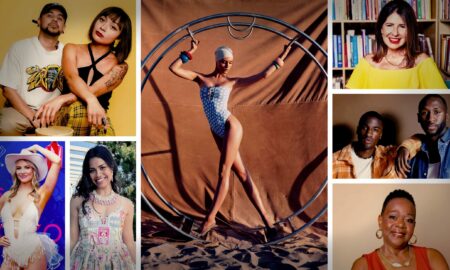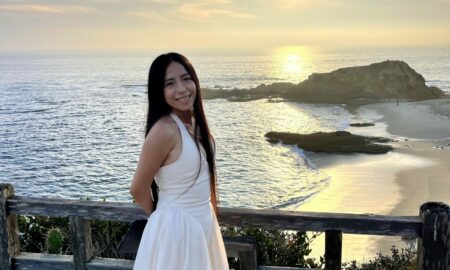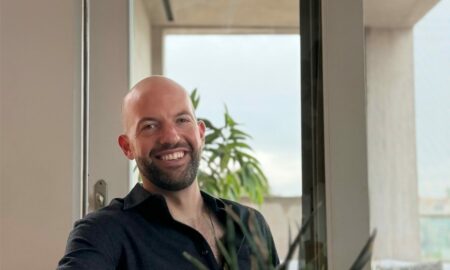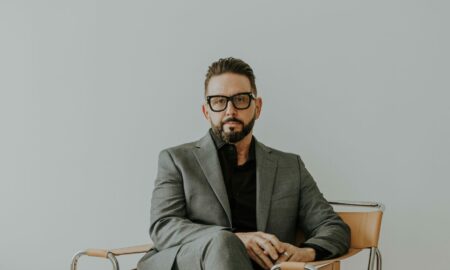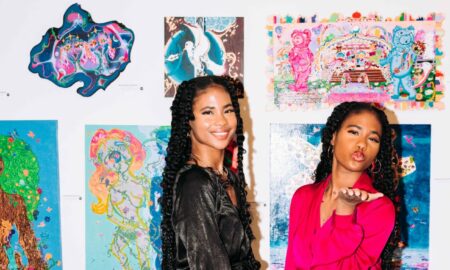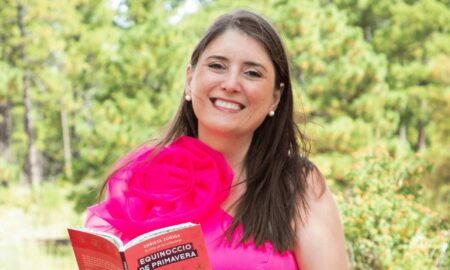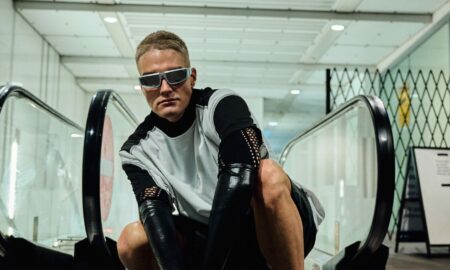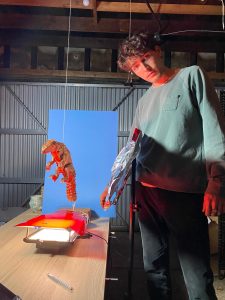
Today we’d like to introduce you to Adam Hersko-RonaTas.
Hi Adam, so excited to have you with us today. What can you tell us about your story?
I grew up between San Diego, California, and Budapest, Hungary, with my mother Judit, an installation artist, and my father Akos, a sociologist. In a household of creativity and statistics, it was difficult not to develop a combined love for art and science.
My interest in performance blossomed first. Starting in elementary school, I acted in stage productions at San Diego Junior Theatre and made short sketches with friends on the weekend, which we shot using my mom’s old cassette camera. Got loads of absurd experimentation out of my system then fortunately. When I was 15, a short film about energy conservation I made at home went on to win awards locally and nationally. After being recognized by the National Energy Foundation, Johnson Controls employed me to create a series on energy conservation for an audience of about 10,000 middle school students across the U.S. A year later in 2012, I directed a small team to create a video used by the B.O.L.D. Project at blood drives around San Diego County to spur donors to sign up for the organ donation registry. My first consistent job was cutting together surfing montages for filmmaker Ira Opper after school. Later in high school, I helped maintain a student film festival started by Julian Clark and Matt Twohig who remain two of my dearest friends. Having found each other through that, we started making more complex short films, testing out what we could pull off with special effects, culminating in a music video for Cloudy Busey’s “Overcame the Sun” that became our initial foray into more serious film festivals. While I knew I wanted to combine my love of visual storytelling with messages I found meaningful, for some reason I hadn’t yet seriously considered filmmaking as a full-on career option. It was somewhat compulsive and probably attractive because it allowed me to create and share contained fantasy-worlds with friends. Perhaps an unwitting extension of my early days doing theater.
As an undergrad at Brown University, I studied cognitive neuroscience and wrote my honors thesis on visual perception, navigation, and virtual reality. One of my favorite courses explored the ecological theory of cognition that posits an inseparable relationship between minds, bodies, and their environments. Though maybe obvious, this further cemented my position that supporting natural ecosystems is vital to mental health. But beyond trying to merge these multidisciplinary passions, I also served as a Managing Director for Brown Motion Pictures, the largest student-run film production organization in the Ivy League. For three years, I helped coordinate, shoot, and screen four short films each semester. For two years, I also worked as the New Media Coordinator at the Ivy Film Festival, organizing the multimedia exhibition that showcased various installations and virtual reality experiences. In 2016 I cold-called Wevr, a virtual reality production company based in LA, which generously allowed me to be their intern for a summer. Then under the mentorship of Luis Blackaller, I shot and edited 360° video content for their burgeoning platform Transport, as well as wrote and directed a series of original VR films over the next few years.
Since then, I’ve continued to produce narrative shorts, music videos, and documentaries. The documentary “Scaling Iceland” that I shot, directed, and edited parallel to my undergraduate thesis, went on to receive international recognition for best student documentary and cinematography. During its festival-run, I was invited to participate in panel discussions about the realities of climate change and its role in storytelling. The multimedia endeavors that consistently bring me the most fulfillment have been the ones that speak to environmental and social justice, though I definitely appreciate the escapist, for-fun shenanigans too and continue to make shorts and music videos often.
Though I don’t believe in predetermination or anything like that, my whole life feels as though it’s been slowly building toward understanding how we perceive our shared natural world and each other through the intersection of art and technology, all while considering more responsible ways to shift perspectives toward a common good. “Good” can mean a lot of things, but I see “good” as being mindful and inclusive in the filmmaking approach so that collaborators have opportunities for meaningful discussions, introspection, and leave with worthwhile memories, not just a shareable product. Right now, I’m supporting myself doing freelance videography and editing jobs while also researching permaculture and carbon-footprint-conscious film production. Specifically, I’m combining these curiosities and filmmaking methods in a feature film I aim to produce in the coming year or so.
Alright, so let’s dig a little deeper into the story – has it been an easy path overall and if not, what were the challenges you’ve had to overcome?
Admittedly the road has been fairly smooth, so far. I’m truly blessed to have wonderful parents who encouraged me to pursue my passions from a young age. It takes serious time to find footing in a world as nebulous as the arts, so I’m eternally grateful for all their support. This isn’t to say I haven’t had my share of disappointments and rejections. For every project I’ve made that’s gotten any sliver of attention, there are literally dozens of others that are collecting dust or fell off the tracks along the way. When there’s no major risk of wasting other people’s time or money, it’s more about process than results for me. I realize this means I sometimes spin my wheels more than I should, but so far that constant iterating is how I’ve learned the most.
A smooth road ironically instills some seeds of doubt in me. It’s a little concerning when you embark on a journey and face few obstacles since I believe that some adversity can build the resiliency and humility crucial for a life in the arts. I don’t want to romanticize the “suffering artist” trope by any means, but I do worry that total comfort can create a disconnect between the artist and the world they may be trying to communicate something truthful about. I try to stay engaged with current events, though I find this can be a challenge when I’m inundated with endless channels of stimulation. This means somehow staying disciplined and not getting distracted by the uninterrupted noise that comes with big city life and the rabbit-holes of the internet. I’m still working on that.
The advice I consistently receive is to always find a way to keep making projects that feel true to you. I’ve wrestled with the reality that each project is its own Sisyphusian task, there are no guarantees even with initial success, and that it’s rare for anyone to champion your own work as much as you will. It’s certainly a struggle to maintain perspective at times. While in school, I filled every hour with studying and creative pursuits. After graduating college, however, the weeks between freelance gigs became a wide open chasm: there weren’t really any clear milestones for me to cling to and so I often needed to remind myself that timescales for projects could expand well beyond the short-term mindset I’d grown accustomed to from semester-to-semester. To endure the long-haul, I’m a big proponent of being the tortoise, not the hare.
Thanks for sharing that. So, maybe next you can tell us a bit more about your work?
I get a lot of joy from fostering the pursuits of fellow up-and-coming artists with technical skills I’ve honed over the past decade. I’ve collaborated with others as a director, cinematographer, animator, and editor, sometimes all those things, to create works that bridge various media forms. These projects range from dramatic narratives to sketch comedy, health/education PSAs to environmental documentaries, stop-motion experiments to music videos. I try not to remain in any one lane and while that makes life more dynamic and varied for me personally, I understand this can spread me a bit thin at times.
What I’m most proud of is that I remain steadfast in creating art for causes I believe in with people I believe in. I avoid certain types of commercial work that I feel promotes products or ideologies I don’t support. I don’t mean to sound self-righteous and I know it’s a privilege to be picky with paid gigs, but I think that integrity is crucial in earning the trust of past and future collaborators. Also not all my work is fueled by some grand “cause” and that’s okay, but like many filmmakers I hope to have an impact beyond entertainment alone. Overall, I find the greatest assurance in having the tangible skills to get the film made and in front of other people. It was definitely the technical constraints that shaped my strongest projects. I’d rather reverse-engineer what’s possible from my environment and a set of available tools than exist within a state of infinite potential.
While I’m far from being established enough to be known for anything in particular, I’m especially drawn toward nature-related themes. Also, people I’ve worked with consider me a jack-of-all-trades, which I have mixed feelings about. It can mean I’m not taken as seriously in one role because I haven’t explicitly specialized in any one skillset. But I think a deep familiarity with each step of the filmmaking process grants me the confidence to take on a broader range of work. Though specialization is celebrated in this world, I’d like to think the future rests in the hands of generalists.
Are there any apps, books, podcasts, blogs or other resources you think our readers should check out?
If you’re an artist looking for grants or freelance business resources, check out Artwork Archive. In terms of inspiration, Richard Powers’ “The Overstory” plays with time, environmental themes, and scope of story so skillfully, it’s probably one of my favorite novels in some time. I also love creative nonfiction, ethnographies, essays, most recently Carl Jung’s “Man and His Symbols.” They serve as a humbling reminder of the countless ways humanity has existed before and how surprisingly little our dispositions have shifted, despite widespread superficial changes to culture. The essay “Create Dangerously” by Albert Camus often lights a fire in me because of what it has to say about art’s potential and how moral responsibility gets wrapped up in that, without justifying “art for art’s sake” or being too preachy. And despite what I said before about the internet, I also find occasional inspiration in forums like Reddit, blogs like “Colossal” or “Feral Atlas” which are teeming with wonderful combos of art and science.
Contact Info:








Image Credits:
Elodie Freymann, Mar Sudac, Emily Adams, Felege Gebru, Erin Jackson
Suggest a Story: VoyageLA is built on recommendations from the community; it’s how we uncover hidden gems, so if you or someone you know deserves recognition please let us know
here.










